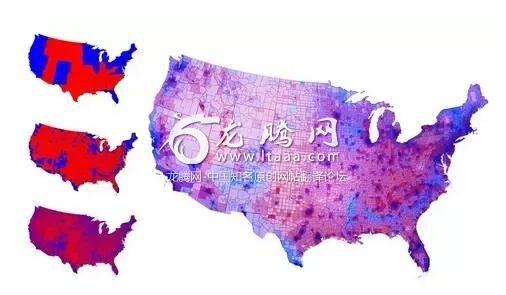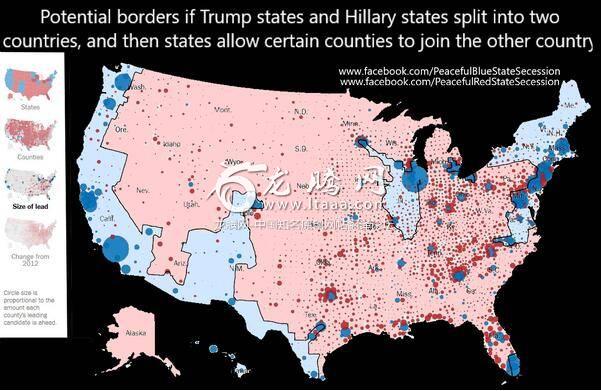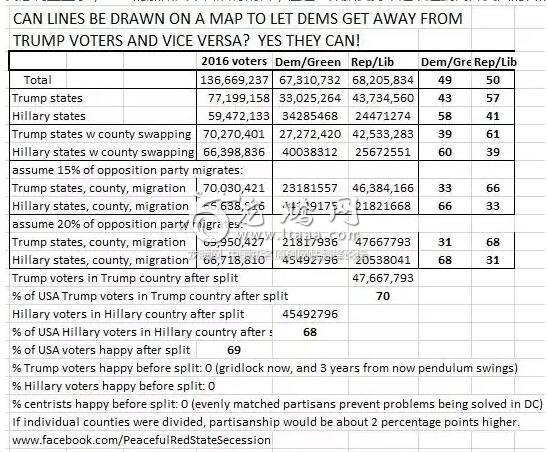为什么我们不能基于政治取向把美国分裂成两个国家呢?(第一部分) [美国媒体]
为什么我们不能基于政治取向把美国分裂成两个国家呢?很明显,这里有蓝色州和红色州。为什么把一方的政治倾向强加给另一个方呢?为什么不分开单独过呢?
Why can't we just split the United States into two nations based on political orientation? It's clear that there are blue states and red states. Why force one sector upon the other? Why not just leave each other alone?
为什么我们不能基于政治取向把美国分裂成两个国家呢?很明显,这里有蓝色州和红色州。为什么把一方的政治倾向强加给另一个方呢?为什么不分开单独过呢?
Visakan Veerasamy, blogs @ visakanv.com · Upvoted by Carter Moore, Degree in Political Science, former Congressional aide and Federal employee · Answered Nov 14, 2012 · 33.7k Views
I found another picture worth sharing in this conversation, courtesy of Gizmodo, the Gadget Guide:
我发现一张图,很适合在这个话题下分享,来自Gizmodo(美国一个知名的科技博客)上面的小玩意指南:
Top Left: Usual representation by state: who won where. One or the other. It shows a big area of red (republican) and some blue (democrat).
Middle Left: Results by county. The divide is even more overwhelming. Visually, it appears as if a few are imposing their will on a huge majority. We know that's not the case, but that's what the maps convey.
Bottom Left: Created by Mark Newman (Department of Physics and Center for the Study of Complex Systems, University of Michigan, it mixes blue and red based on popular vote percentage instead of showing a binary representation.
There's no huge area of red. There is a gradient. A lot of purple. That's the accurate map that reflects the actual result of the election. It also shows that the divide between the cities and the countryside is not that huge. There are differences of opinion everywhere.
MAIN: It factors in population density, showing the importance of every county based on the population. The lighter the color, the less populated, the less weight in the election. The more saturated it is, the more populated and more weight it shows.
(CC: Tyler Peterson, Jeremy Hoffman, Joshua Engel, Ben Biber, Jaclyn Le, and Ise Varghese Mac)
Personally, I don't see why we still use the first image when we could use the main one, which conveys far more information in a simple-to-understand way.
左上角:通常显示的是赢家。不是这个就是那个。它显示了一个大面积的红色(共和党)和不太多的一些蓝色(民主党)。
中左:按县划分的结果。这一分歧甚至更加严重。从视觉上看,似乎有少数人把他们的意志强加给了绝大多数人。但我们知道实际情况并非如此,但地图所显示的信息就是如此。
左下角:由马克纽曼(密歇根大学物理系和复杂系统研究中心)创建,它根据受欢迎的得票率混合蓝色和红色,而不是单纯的只用二进制方法表示。没有大面积的红色。有一个梯度。出现了很多紫色。这是反映选举实际结果的准确地图。这也表明,城乡之间的差距并不大。到处都有不同的意见。
主要内容:它显示了人口密度因素的影响,体现了每个县以人口为基础的重要性。颜色越淡,人口越少,在选举中的份量就越小。它的饱和程度越高,它所显示的人口就越多,重量也越重。
(cc:泰勒·彼得森、杰里米·霍夫曼、约书亚·恩格尔、本·比伯、杰克琳·勒和伊塞·瓦尔盖斯·麦克)就我个人而言,我不明白为什么我们仍然使用第一张图像,而我们明明可以使用主图像的,它能以一种简单易懂的方式传递更多的信息。
Chris Rhodes, researcher for www.facebook.com/PeacefulRedStateSecession · Updated Mar 1, 2018 · 15.5k Views
The answer is we can split the USA, but it hasn’t happened yet because of myths like secession is illegal and secession leads to war.
Can lines be drawn on a map so that most Democrats will no longer have people like Trump as their President? The answer is yes! The problem of purple states can be solved by allowing counties to secede.
The average Trump state voted 57% for a Republican or a Libertarian, and 43% for Hillary or Jill Stein. The Hillary states voted 41%/58%.
However, if counties are allowed to split off to join the other country, the Trump states would be 61%/39%, and the Hillary states 39%/60%. If 20% of the opposition party eventually migrated to the other country, the Trump states would be split 68%/31% and the Hillary states 31%/68%. Allowing individual counties to be divided would increase the split to perhaps 69%/31%. The beauty of this is that people who really care about the effects of public policy can move, but no one has to move.
I see splitting the USA as a way to defuse the culture war in a peaceful way. The red states could follow the Constitution as it was written, and the blue states would explore nationalized medicine, national gun prohibition, liberal federal judges, open immigration, etc. But even after splitting, none of the states would be ideologically uniform, so the opposition party could co-opt the moderates and be electable. The Blue state country would become like the UK and Canada (with warmer weather and Latinos), and the red-state country would become like the 1980s USA.
The point is not to get ideological uniformity. The point is to allow people who really care to live in a country that reflects their world view. In the end, 71% of Trump voters and well over 69% of Hillary voters would get to see their aspirations realized. Neither camp is happy in the Union because we are always obstructed by the other side from making progress in DC. Even centrists today are not happy because the evenly-matched camps cause gridlock, preventing practical problems from being solved.
A 2017 Zogby poll shows that 68% of Americans are now open to secession, and secession has more supporters than detractors. Support for secession is now 39%, double what it was three years ago. Democrats now support it more than Republicans, and the West Coast and North-East rival the South in support for secession. Washington DC has been dysfunctional and gridlocked for decades. Democrats don’t want to associate with red state people that would vote for Trump.
As of March 2017, 44% of Democrats in California are in favor of the secession of California from the USA. If attention to this issue due the California ballot referenda can increase that number above 50%, California could create a precedent for peaceful, orderly secession by referendum or a vote of the state legislature. After the precedent is set, red states such as Alabama could secede and band together with other seceded red states.
National assets, such as military assets, and national debts would be divided. No civil war is necessary if seceding states differ from the Confederacy by following 2 simple rules: don't enslave anyone, and don't attack Fort Sumter. The EU is not attacking the UK for seceding. The UK gave permission to Scotland to hold a referendum on secession in 2015. Canada allowed Quebec to vote on secession peacefully.
Check out Peaceful Red-State Secession
68% poll: http://johnzogbystrategies.com/n ... -trump-report-card/
44% poll: Californians don't like Trump, but not enough to leave the U.S.
答案是我们可以分裂美国,但它还没有发生,因为分裂的是非法的,并且会导致战争。
可以在地图上画条线,这样大多数民主党人就再也不会有像特朗普这样的总统了吗?答案是肯定的!至于紫色那部分,国家可以通过允许不同派别分县出来解决。
特朗普州共和党或自由主义的平均投票率为57%,而希拉里或Jill Stein则为43%。希拉里州投了41%票/ 58%票。
然而,如果允许各县分道扬镳加入其他州,特朗普州将占到61%/39%,希拉里州将占39%/60%。如果20%的反对党最终迁移到另一个州,特朗普州将被分裂68%/31%,希拉里州将为31%/68%。允许各县(按照派别)划分,将使这一比例增加到69%/31%。这样做的好处是,真正关心公共政策效果的人可以搬家,但不是非迁不可。
我认为划分美国是和平化解文化战争的一种方式。红州可以遵循宪法,蓝色州可以继续探索国有化的医学,采取国家枪支禁令,自由联邦法官制度,开放移民等。但是即使在分裂之后,也不会有一个州在意识形态上是统一的,所以反对党可以选择温和派,并且让其当选。这个蓝色国家将变成英国和加拿大(气候变暖,拉丁裔),而红色国家将变成1980年代的美国。
关键不在于实现意识形态的统一。关键是让真正关心的人生活在一个反映他们世界观的国家。最终,71%的特朗普选民和超过69%的希拉里选民将看到他们的愿望得以实现。在联盟中,两派都不高兴,因为我们总是被对方阻挠,无法在华盛顿取得进展。就连今天的中间派也不高兴,因为势均力敌的阵营造成了僵局,阻碍了实际问题的解决。
2017年佐格比的一项民意调查显示,68%的美国人现在对分裂国家持开放态度,而分裂国家的支持者多于反对者。目前,支持分裂国家的比例为39%,是三年前的两倍。民主党人现在比共和党人更支持它,西海岸和东北地区在支持分裂国家方面与南方竞争。华盛顿特区几十年来一直运转不良,陷入僵局。民主党人不想与支持特朗普的红州民众扯上关系。
截至2017年3月,加州44%的民主党人支持加州脱离美国。如果加州全民公决对这一问题的关注能使这一数字增加到50%以上,加州就可以通过全民公决或州立法机构的投票为和平、有序的分离创造先例。在先例被确立之后,像阿拉巴马这样的红色州可以与其他脱离的红色州相结合。
国家资产,如军事资产和国债将被分割。假设有州要分离,他们应该与邦联言明两条简单的规则:不要奴役任何人,也不要攻击
苏姆特堡(此处象征意义,唯一南卡罗来纳州,曾是美国内战激战处);那么就不会发生内战。欧盟并没有因为英国脱离欧盟而攻击英国。英国允许苏格兰在2015年举行一次独立公投。加拿大允许魁北克和平投票表决分离。
红色的和平-民意调查68%的人支持国家分裂:
http:/johnzogbyStratgies.com/n.-trump-Report-Card/
民意调查显示,44%的加州人不喜欢特朗普,但这一数据支持不足以达到离开美国的目的。
My map is explained here: Chris Rhodes' answer to If the USA split into separate countries based on ideology, how could it be done since the population is so geographically intermixed?
我对地图是这样理解的:克里斯·罗兹)的答案是,如果美国基于意识形态分裂成不同的国家,在地理上人口如此混杂的那部分要怎么办?
Geoffrey Widdison, Been following US politics as long as I've been able to vote.
Upvoted by Carter Moore, Degree in Political Science, former Congressional aide and Federal
employee · Updated Nov 20, 2017 · 30.4k Views
You've got a vastly oversimplified view of the country. Red states and blue states are media graphics. Look at county by county results, or, better yet, precinct by precinct. Every state in this country has Republicans and Democrats. Even the most extreme states on either side aren't more than 70% one way or the other. The big cities in even the red states tend to be liberal, the rural areas in even the blue states tend to be conservative.
For example, California only voted 59% for Obama, only 5M votes. Imagine forcing the remaining 41% of the state--basically everyone outside LA & SF--to leave. Or imagine basically evacuating every large city in the "red" states. Dallas, Austin, Houston, New Orleans, Atlanta, Omaha, even Salt Lake City... Either all the liberals in there would have to be forced from their homes (which would be monstrous), or they'd have the political beliefs of others "forced" on them, which would basically defeat the whole purpose.
The point is, there is no "they". The nation is a huge and complex society with disagreements and differing concerns at every level. Trying to balkanize the nation into sub-countries consisting entirely of people who agree with one another won't work. It would just divide the country along fairly arbitary lines, sever lines of trade, communication, transportation and education, separate families and friends and create new international borders which would be the scene of ever greater conflict.
Moreover, the disagreements in the country tend be pretty grossly exaggerated. The people who are most jingoistically certain of their political position are the loudest and get the most attention. Most people lie somewhere in the center. They may have sympathies with one party or the other, but most Democrats don't really think Mitt Romney is a fascist and most Republicans don't really think Obama is a Kenyan socialist. I'm the first to agree that we have too much political divisiveness in this country, but it's not to the point where we should or could divide the country over it.
Every four years this country has a completely civilized, bloodless coup and, if the electors say so, the most powerful man in the world hands over the reigns of power and retires to play golf. Idiots like Trump may rant about revolution but, at the end of the day, the members of the losing party accept the results and go on about their lives. These are not the actions of people who can't accept each other's philosophies.
你对这个国家的看法过于简单化了。红色州和蓝色州是媒体在地图上搞出来的。看看县的结果,或者更好选择的是,看辖区。这个国家的每个州都有共和党和民主党。即使是任何一方中最极端的州也不会超过70%。即使是红色州的大城市也倾向于自由主义,即使是蓝色州的农村地区也倾向于保守。
例如,加利福尼亚只为奥巴马投了59%票,只有500万张选票。想象一下,迫使州内剩下的41%——基本上所有的人都搬离洛杉矶和旧金山——离开。或者想象一下基本上解散了“红色”州的每一个大城市。达拉斯,奥斯汀,休斯顿,新奥尔良,亚特兰大,奥马哈,甚至盐湖城.要么所有的自由主义者都得被迫离开他们的家园(这将是可怕的),要么他们接受会有其他人的政治信仰“强迫”套在他们身上,这中方式基本上完全破坏了所有好的出发点。
重点是,不要说什么“他们”。这个国家是一个庞大而复杂的社会,在各个层面上都存在分歧和不同的关注点。试图把这个国家变成一个完全由意见一致的人组成的亚国家是行不通的。它将按照相当武断的路线将国家分割开来,切断贸易、通讯、运输和教育的界线,分离家庭和朋友,并建立新的国际边界,这将引发更大的冲突。
此外,这个国家的分歧往往被严重夸大了。最能肯定自己政治地位的人是最亮眼、最受关注的人。大多数人都躺在中间的某个地方。他们可能赞同这个,也同意那个,但大多数民主党人并不认为米特·罗姆尼是法西斯主义者,大多数共和党人也不认为奥巴马是肯尼亚社会主义者。我是第一个同意我们在这个国家有太多政治分歧的人,但这并不是说我们应该或可能在这个问题上分裂这个国家。
这个国家每四年都会发生一场完全文明、不流血的政变,如果选民这么说的话,世界上最有权势的人就会交出权力,退休去打高尔夫。像特朗普这样的白痴可能会对革命大声咆哮,但最终,败选党的成员会接受结果,继续他们的生活。就算彼此不能接受对方的哲学也不应该有这种行为。
Phyllis S. Holden · Answered Jul 8, 2016 · 835 Views
First, the “red” and “blue” states’ maps are political ones, images initiated on television shows well after commercial receivers went on sale in USA cities — to teachers first — in the 1940s and 50s. Broadcasters remain where they are licensed for the property (real). Take a look at any satellite picture-map for approximations of real Earth colors.
This is a nice movie with aerial close ups of some fantastic views, published in many translations:
The question as set is “cannot” — technologically self explanatory [we cannot]. The first reason would be there is no party of persons on any of the ballots for the major “teams” advocating partitioning …again. The whole world has been partitioned off politically by the forces of nation-states’ populations, by persuasion and by forces up to and including the bombing of Earth even at the home countries with radioactive metal fuels. None of the political parties is in charge of ALL the military forces and tools (satellites and other remote-control lenses).
In fact, major concerns of present years has been the fears of the nation-state leaders in the UN of military forces taking over a state, as in nationalization (Cuba; England briefly; the English, French, Spanish, Portuguese colonies…). In those matters in the USA, Canada, Mexico open lands, “red” is the traditional “redcoats” color (hard to dye permanently) and “blue’ the federalists, USA and France after the royal partitioning of the interior lands and waterways already cultivated and defended, with many planned cities already founded and under construction by engineers and architects from 1492 — Earth around. It is important to recall that we stay on one planet at the same time as others with nation-state boundaries, too, defended. The capitals stay where they are and have been “amended” daily up to today’s watchers.
US political parties are not nations and also have no state — meaning they are not families intermarrying to produce sons and daughters, lack business and cultural ties historically to the present. The whole Richard Nixon resignation for benefit of the Republican Party started with an industrial espionage attempt to see the Democrats’ central office files at the Howard Johnson building, across from the Watergate. Before civilized more, the opponents would sometimes brawl in office, at the Capitol. Ancestral conditions like that operate still in city meetings at Belfast and at London — but only in private sessions do they pummel press representatives at the middle tables between majority-minority representatives.
首先,“红色”和“蓝色”州的地图用色用在政治上只是其中一项用途,在美国商业广告发售后,电视上用这两种颜色播放的图像显示得很好,教师们首先开始使用这东西,广播公司仍然保留着这东西(真的)。看一看随便一个卫星图片-地图,更接近真实的地球颜色。
这是一部很好的电影,有一些精彩的空中特写镜头。
所设定的问题是“不能”——技术上是不言自明的[我们不能]。第一个原因是在主要的“团体”投票中没有一个人支持分区,再者,整个国家在政治上会被民族国家通过劝说、武力,甚至包括在地球使用放射性燃料的轰炸力量而隔绝,。没有一个政党能承担起所有的军事力量和设备(卫星和其他遥控镜头之类的)
事实上,当前主要的忧虑是联合国国家领导人对依靠军事力量接管一个国家的恐惧,比如民族化(古巴;英国,法国,西班牙,葡萄牙殖民地等等)。在美国、加拿大、墨西哥开放的土地上,“红色”是传统的“红衣”颜色(很难永久染色)而“蓝色是”联邦主义者,在皇室被隔离后美国和法国已经将内陆的土地和巷道耕种和保护了起来自1492年以来,许多规划中的城市由工程师和建筑师们已经建立或正在建立-环绕地球。重要的是要记住,我们和其他国家同时呆在一个星球上——有边界需要防守。直到今天首都保持原样,观察者们每天都在“修正”。
美国政党不是国家,也不能代表国家-这意味着它们不是一个为了生育子女而彼此通婚的大家庭,从历史上看,它们缺乏商业和文化联系。理查德·尼克松(RichardNixon)为了共和党的利益而辞职,水门事件一开始只是一次工业间谍活动,有人试图在对面的霍华德·约翰逊H大楼查看民主党的中央办公室档案。在变得更文明之前,反对者有时会在国会大厦的办公室里争吵。甚至是在贝尔法斯特和伦敦的城市会议上,这样的先前出现的情况仍然存在,但只有在非公开会议上,他们才会在多数党代表之间的中间席位上殴打记者代表。
Zachary Newell · Answered Jun 11, 2015 · 8.3k Views
The book American Nations: A History of the Eleven Rival Regional Cultures of North America by Colin Woodard has a very interesting and deep perspective on cultural divisions within the United States. The author divides the continent up into several regions (which do not follow state lines or even national boundaries) by examining the cultural origins of each. It is much more complex than what you see in voting patterns and yet you can see where those patterns come from. This article is about the book and presents a brief overview:
Which of the 11 American nations do you live in?
He does have one chapter that talks about splitting the country along those lines. I think it would be difficult because it would be most convenient to split along state lines...but those boundaries don't actually define our cultural divisions very well (and you can see in several places around the world how arbitrary boundaries cause problems). However, my opinion is that the things that unite us as Americans are stronger than those things that divide us. In fact, one of the core principles of our nation is that it is made up of very diverse elements working together. The US has survived many challenges to its unity and I'm more optimistic about that union being maintained for the foreseeable future.
To actually answer the question, I think that the only way to amicably split the US would be to do so along cultural lines more or less like those in Woodard's book...with any necessary corrections or adjustments to account for geography and/or more complete information about the composition of those regions. It's also possible that some of those regions, having similar mindsets, could join in their own smaller unions.
Here is a list of Woodard's nations; the article linked above has a map and descriptions of each...but the article's descriptions (and mine) are necessarily light and don't quite convey the full characteristics of each (and I apologize, some of these may descend into stereotype...it's hard to get the nuance in a sentence or two, so please take with a grain of salt):
Yankeedom: covers New England and the northern Mid-West: comes from a Puritan cultural background that values education and engineering society as a whole.
New Netherland: essentially New York City and surrounding areas: coming from the commerce-oriented Dutch colony, it has a focus on diversity and, well, commerce.
The Midlands: a narrow band that starts in New Jersey/Pennsylvania and goes west into the Mid-West before splitting north and south; also includes large portions of Manitoba and Ontario: this area has cultural origins from the Quakers and German settlers with an open and welcoming attitude but resistance to outside interference.
Tidewater: covers eastern Virginia and North Carolina with spots in Maryland and Delaware: comes from the English manor country and a tradition of aristocracy.
Greater Appalachia: a wide swath of the country that one might consider the border area between the North and South: initially populated by English, Scottish, and Irish settlers trying to get away from authority, there are strong values of individual liberty.
Deep South: covers the southernmost parts of the South: this area had its origins in the English slave colonies of the West Indies, ending up basically as a more intense version of Tidewater (and with a brutally racial hierarchy).
New France: the area around New Orleans + Quebec: these are the remnants of the French colonies, which valued cooperation and peace with neighbors.
El Norte: the southern areas of the Southwest and the northern areas of Mexico: as these were the far borderlands of New Spain (and later Meixco), this region developed values of self-sufficiency and independence. Ironically, and according to Woodard's book, Northern Mexico actually has more in common with the US in values than the El Norte portion of the US has with Mexico.
The Left Coast: the western edges of the Pacific states and British Columbia: colonized by Yankees and Appalachians, this region has values of social progress and individual liberty (with a strong streak of environmentalism).
The Far West: the huge area of deserts and plains between the Left Coast and the western edge of The Midlands: a decidedly harsher area of the continent, the people of this region depended on (and were exploited by) either corporations and/or the government, resulting in distrust towards both.
First Nation: Northern Canada and Alaska: Native American lands that have maintained their sovereignty.
As a note, southern Florida is separate and considered as an extension of the Caribbean cultural sphere; Hawaii is also separate.
It's a very interesting book; check it out! Full disclosure: the author appears to be from New England (the traditional cultural foe of the Deep South) so it may have more of that perspective...and further full disclosure: I'm from the Left Coast and now live in New England so I may be biased...
科林·伍达德着的“美国国家:北美十一个竞争区域文化的历史”一书,对美国国内的文化分歧有着非常有趣和深刻的视角。作者通过考察每个地区的文化渊源,将大陆划分为几个区域(这些区域不遵循国家界线,甚至不遵循国界)。它比你在投票模式中看到的要复杂得多,但你可以看到这些模式从何而来。这篇文章是关于这本书的,并作了一个简要的概述:可以对照看看你住在11个美国州中的哪个州?
他确实有一章谈到按照这些方针分裂这个国家。我认为这是很困难的,因为按照州划分是最方便的.但是这些边界实际上并没有很好地定义我们的文化划分(你可以在世界上的几个地方看到随意划分边界是如何造成各种纠纷麻烦的)。然而,我的观点是,把我们作为美国人团结在一起的东西比那些分裂我们的东西更强大。事实上,我们国家的核心原则之一是,它是由非常多样化的因素共同组成的。美国的团结经历了许多挑战,我对在可预见的将来维持这个联盟更加乐观。
要真正回答这个问题,我认为,友好地分裂美国的唯一途径是,在文化层面上或多或少像伍达德书中的那样…作出任何必要的修正或调整,以考虑到地理和/或更完整的有关这些地区组成的信息。也有可能,这些地区中的一些,有着相似的心态,可以加入他们自己的小联盟。
下面是伍达德国家各州名单;上面链接的文章内有一张地图和每一篇文章的描述.但这篇文章的描述(和我的放上来的)都是轻描淡写的,并不能很好地传达每个州的全部特征(我很抱歉,其中有些可能会演变成刻板印象…很难在一两句话内解释清楚它细微之处,所以会稍加说明):
洋基:涵盖新英格兰和中西部北部:文化背景来自清教徒,重视整个教育和工程社会。
新尼德兰:本质上是纽约市及其周边地区,来自以商业为导向的荷兰殖民地,它注重多样性,而且,嗯,商业化。
中部:一个狭窄的长条,从新泽西/宾夕法尼亚州开始,然后在南北分离前向西进入中西部,;还包括马尼托巴省和安大略省的大部分地区:这一地区的文化起源于贵格派教徒和德国定居者,真题持有开放和欢迎的态度,但抵制外来干涉。
泰德沃特:覆盖弗吉尼亚州东部和北卡罗莱纳州,在马里兰州和特拉华州的景点则来自英国庄园和贵族的传统。
大阿巴拉契亚:一片广阔的国土,人们可以把它看作南北边界地区:最初居住在那里的是英格兰、苏格兰和爱尔兰的定居者,他们试图摆脱权威,他们有着强烈的个人自由价值观。
南方深部地区:覆盖南方最南端,这一地区起源于西印度群岛的英国奴隶殖民地,最终基本上成为一个更强烈的泰德沃特版本(具有残酷的种族等级)。
新法兰西:魁北克新奥尔良周边地区,这些都是法国殖民地的残余,这些殖民地珍视与邻国的合作与和平。
北方:西南部的南部地区和墨西哥的北部地区,由于这些地区是新西班牙(后来的梅斯科)的边境线,这个地区发展出了自给自足和独立的价值观。具有讽刺意味的是,根据伍达德的书,北墨西哥实际上在价值观上与美国有更多的共同之处,而美国与墨西哥的北部部分却没有任何共同之处。
左岸:太平洋各州和不列颠哥伦比亚省的西部边缘:被北方佬和阿巴拉契亚人殖民,这个地区有社会进步和个人自由的价值观(带有强烈的环保色彩)。
最西部:左海岸和中部西部边缘之间的大片沙漠和平原:这片大陆上最严酷的地区,这个地区的人民依赖(并被)公司和/或政府剥削,导致了他们对两者的极度不信任。
第一原住民部族区:加拿大北部和阿拉斯加:维护其主权的美洲土着们的领地。值得注意的是,南佛罗里达是独立的,且被认为是加勒比文化领域的延伸;夏威夷也是独立的。
这是一本很有趣的书,看看吧!完全披露:作者似乎来自新英格兰(南方深部地区传统文化敌人),所以它可能有更多的这种观点。还有进一步的全面披露:我来自左海岸,现在住在新英格兰地区,所以我可能也有偏见。
Mark Lambert, TPM at Facebook (2017-present) · Answered Jan 6, 2018 · 458 Views
Too many of these answers fixated on (admittedly cool) maps filled with really nifty color distributions. Also, they’re all way too old.
Here in 2018, things look a *lot* different than “just” 6 years ago.
Forget Democrat/Republican, Blue/Red…. The country is bitterly and *deeply* divided by *issues* and, in many critical cases, these issues are very strongly tied to race. Let’s use some real examples. If someone feels that the tiki torch crowd in NC included some “very fine people” and that Black Lives Matter is a terrorist organization, there is *very little chance* they are going to find some happy common ground with progressives.
Similarly, if you are absolutely against abortion regardless of circumstance, because it is against the “will of God”, you will *never* find a happy common ground with someone pro-choice.
Now rinse and repeat across a *laundry list* of equally divisive issues. Each year, the bitterness and resentment each side feels for the other grows as does how entrenched they are in their positions.
Meanwhile the GOP, now having absolute power, primarily cares about deregulating every industry, giving massive tax breaks to $1M+ earners and massive corporations, dismantling “entitlement programs” (ie - social security and medicare), and wiping out *all* environmental protections. Conservatives seem *thrilled* with all of this. *All* of it is *horrifying* to progressives.
These are real issues and in some cases are considered life or death. The romantic and folksy notion that “we’re all really the same!” or, “we’re more similar than different!” only ever appeared true when the country was nearly entirely white and conservative.
这些答案中有太多都是专注于(虽然真的很酷)地图,地图上充满了非常漂亮的颜色分布。然而他们都太老套了。
在2018年,事情看起来与6年前的“仅仅”不同。
忘记民主党/共和党,蓝色/红色…。这个国家深受*问题的影响,在许多关键情况下,这些问题与种族密切相关。让我们举一些实际的例子。如果有人认为北卡罗来纳州的蒂基火炬人群中包括了一些“非常优秀的人”,认为“黑人命贵”是一个恐怖组织(次次都烧打抢砸结尾难道不是么?),那么他们就很难与进步人士找到共同点。
同样,如果你不管情况如何完全反对堕胎,就因为这违背了“上帝的旨意”,你将永远不会和别人找到共同点,一个进步赞成有多种选择的人。
现在,在同一个引起分歧的问题的清单上,洗脑然后一边又一遍的重复。每一年,双方对彼此的怨恨都在增加,就好像他们天生就有如此根深蒂固的怨恨似的。
与此同时,现在拥有绝对权力的共和党,主要重点放在了放松对每一个行业的管制,给予百万美元收入者和大型企业以巨大的税收优惠,然后废除“福利计划”(即社会保障和医疗保险),并且消灭*所有*环境保护主义者。保守派似乎对这一切感到兴奋。然而这一切对于进步人士来说,所有这些都是骇人听闻的。
这些都是真实的问题,在某些情况下被认为是关乎生死存亡的。浪漫的民间观念是“我们都是一样的!”或者,“我们并非不同只是更相似!”只有在这个国家几乎完全是白人和保守主义者的时候,才会如此。
版权声明
我们致力于传递世界各地老百姓最真实、最直接、最详尽的对中国的看法
【版权与免责声明】如发现内容存在版权问题,烦请提供相关信息发邮件,
我们将及时沟通与处理。本站内容除非来源注明五毛网,否则均为网友转载,涉及言论、版权与本站无关。
本文仅代表作者观点,不代表本站立场。
本文来自网络,如有侵权及时联系本网站。
图文文章RECOMMEND
热门文章HOT NEWS
-
1
Why do most people who have a positive view of China have been to ...
- 2
- 3
- 4
- 5
- 6
- 7
- 8
- 9
- 10
推荐文章HOT NEWS
-
1
Why do most people who have a positive view of China have been to ...
- 2
- 3
- 4
- 5
- 6
- 7
- 8
- 9
- 10













